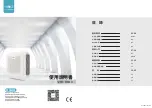
8
ADDITIONAL NOTES:
1. There are (4) LEDs on the PCB. See the
Troubleshooting
Tables
at the end of this manual
for definitions of the
LED status.
2. When system is at Standby mode, press “TEST” push
button to turn on both compressor and outdoor fan for
five (5) seconds.
3. Press “RECALL” push-button to retrieve the six most
recent faults. The control must be in Standby Mode (no
thermostat inputs) to use the feature. Depress the push-
button for approximately two seconds and less than five
seconds. The LEDs will then display the six most recent
faults beginning with the most recent fault and
decrementing to the least recent fault. The faults may
be cleared by depressing the button for greater than five
seconds. Consecutively repeated faults are displayed
a maximum of three times. Refer to the fault code
definitions at the end of this manual for more details.
4. “TERM” dipswitch is used for communications bus
configuration. Leave the settings to the factory default
position.
5. “LEARN” push button is used in communication mode
to support device recognition on start-up. As the
communication system supports automatic identification
of both indoor unit and outdoor unit, this button is not
used for a normal start-up.
C
OMFORT
N
ET
™ S
YSTEM
O
VERVIEW
The ComfortNet system (or CT system) is a system that in-
cludes a ComfortNet compatible air handler/furnace/modular
blower and air conditioner or heat pump with a CTK0*AA ther-
mostat. Any other system configurations are considered in-
valid ComfortNet systems and must be connected as a tradi-
tion (or legacy) system. The table below compares the valid
CT systems.
CT compatib le
Air Handler/Furnace/Modular
Blower
CT compatib le
Air Conditioner
Full CT system
b enefits & features
CT compatib le
Air Handler/Furnace/Modular
Blower
CT compatib le
Heat Pump
Full CT system
b enefits & features
A ComfortNet heating/air conditioning system differs from a
legacy/traditional system in the manner in which the indoor
unit, outdoor unit and thermostat interact with one another. In
a traditional system, the thermostat sends commands to the
indoor and outdoor units via analog 24 VAC signals. It is a
one-way communication path in that the indoor and outdoor
units typically do not return information to the thermostat.
On the other hand, the indoor unit, outdoor unit, and thermo-
stat comprising a ComfortNet system “communicate” digitally
with one another. It is now a two-way communications path.
The thermostat still sends commands to the indoor and out-
door units. However, the thermostat may also request and
receive information from both the indoor and outdoor units. This
information may be displayed on the CT thermostat. The in-
door and outdoor units also interact with one another. The
outdoor unit may send commands to or request information
from the indoor unit. This two-way digital communications
between the thermostat and subsystems (indoor/outdoor unit)
and between subsystems is the key to unlocking the benefits
and features of the ComfortNet system.
Two-way digital communications is accomplished using only
two wires. The thermostat and subsystem controls are pow-
ered with 24 VAC Thus, a maximum of 4 wires between the
equipment and thermostat is all that is required to operate the
system.
A
IRFLOW
C
ONSIDERATIONS
Airflow demands are managed differently in a fully communi-
cating system than they are in a legacy wired system. The
system operating mode (as determined by the thermostat)
determines which unit calculates the system airflow demand.
If the indoor unit is responsible for determining the airflow de-
mand, it calculates the demand and sends it to the ECM motor.
If the outdoor unit or thermostat is responsible for determining
the demand, it calculates the demand and transmits the de-
mand along with a fan request to the indoor unit. The indoor
unit then sends the demand to the ECM motor. The following
table lists the various ComfortNet™ systems, the operating
mode, and airflow demand source.
Sys te m
Sys te m
Ope r ating M ode
Air flow De m and
Sour ce
Cooling
A ir Conditioner
Heating
A ir Handler
Continuous Fan
Thermostat
Cooling
A ir Conditioner
Heating
Furnace
Continuous Fan
Thermostat
A ir Condi
A ir Handler
A ir Condi
Furnace









































